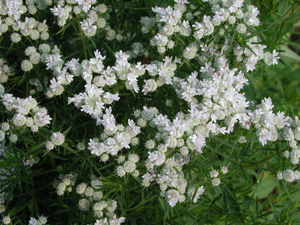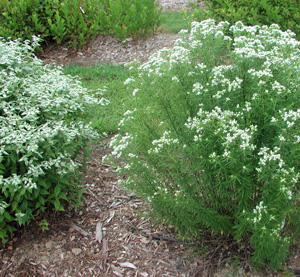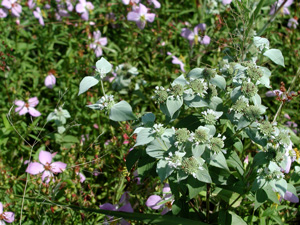Resource Library
Plant of the Week: Mountain Mint
The University of Arkansas System Division of Agriculture does not promote, support or recommend plants featured in "Plant of the Week." Please consult your local Extension office for plants suitable for your region.
Plant of the Week
Mountain Mint
Latin: Pycnanthemum

Tough plants are good, but with toughness, there comes tradeoffs that can come back and bite you if growing conditions are too good. Mountain mints, genus Pycnanthemum for example, are great plants for really tough growing conditions, but given a rich flower border they will try to take over.
About 20 species of mountain mints are described in the southeastern states. They belong to the mint family and when the foliage is crushed share the distinctive aroma of that group. Botanically they are most closely related to Monardas but have smaller flower heads and generally occur in drier sites than that indigenous group of plants.
Mountain mint plants are rhizomatous perennials that grow 2 to 3 feet tall and will spread as wide as conditions allow. They have slender upright stems that have oppositely arranged leaves that are either broadly lanceolate in form or narrow and willow-like in appearance.
All mountain mints have small tubular white flowers about one-quarter of an inch across with five lips, with the lower three more pronounced. The blossoms are arranged in a compact cluster at the ends of the stems. In some species, the flowers sit atop broad, gray-pubescent bracts which are showier than the flowers. Plants are in flower over an extended period from late spring through much of the summer, and because of this, are favorites with butterflies and bees.

The crushed leaves of mountain mints have been used as insect repellents and in herbal teas, but generally they are used as part of the meadow or woodland garden where the plants pretty much fend for themselves once established. In the wild they are often found at the forest edge or in mixed in woodland meadows. Pycnanthemum albescens and P. muticum have the showy grayish bracts while P. incanum and P. tenuifolium have willowy leaves and showier flowers.
Mountain mints are easy to grow from seed with plants best started indoors in late winter. Plant out after the fear of frost is past and plants will be well established by the end of the growing season. While best in full sun, they will tolerate moderate shade. A planting of P. albescens in my dry shade garden 15 years ago is still thriving but it has colonized parts of the area like groundcover bamboo. So be careful where mountain mints are planted. In good soil, they will take over neighboring plants and become a hard-to-get-rid-of weed. Plant them where they can roam freely and their spread controlled by mowing or trimming. Purveyors of native plants will have mountain mints.
By: Gerald Klingaman, retired
Retired Extension Horticulturist - Ornamentals
Extension News - August 31, 2012

The University of Arkansas System Division of Agriculture does not maintain lists of retail outlets where these plants can be purchased. Please check your local nursery or other retail outlets to ask about the availability of these plants for your growing area.